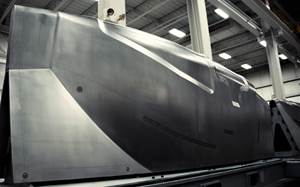NCDMM, Ingersoll, Orbital ATK complete automated composites inspection system
The Automated Composite Structure Inspection System achieved a defect detection rate of up to 99.7% on aircraft components produced via automated fiber placement.
The National Center for Defense Manufacturing and Machining (NCDMM), in partnership with Ingersoll Machine Tools Inc. (Rockford, IL, US) and Orbital ATK (Clearfield, UT, US), reports the successful completion of Phase I of a three-year project to develop an automated composites inspection system for the Air Force Research Laboratory (AFRL) at Wright-Patterson Air Force Base (AFB) in Ohio funded through the Defense-wide Manufacturing Science and Technology (DMS&T) program.
The newly developed Automated Composite Structure Inspection System (ACSIS) achieved a defect detection rate of up to 99.7% in aircraft components produced by automated fiber placement (AFP) that featured varying geometries, ranging from flat to complex.
ACSIS represents a significant step forward from the current manual AFP inspection practice, which is extremely time consuming, laborious and visually tedious as defects are difficult to discern. With ACSIS, inspections occur in real-time while the composite structure is being fabricated, alerting the operator and allowing defects and anomalies to be detected and repaired during the fabrication process. The developed system also includes an electronic database system to electronically document and track defects.
For Phase 1, NCDMM initially worked with Ingersoll Machine Tools in the development of an on-tool inspection system. Then, NCDMM partnered with Orbital ATK for the beta site implementation testing of the ACSIS, developed by Ingersoll Machine Tools, during AFP production.
In the spring of 2015, ACSIS was installed as a standalone system, independent of an AFP machine into the production environment of F-35 Lightning II nacelles at Orbital ATK’s Clearfield facility. ACSIS was tested and compared side-by-side with the baseline manual inspection process, identifying such defects as missing or twisted tows; gaps between tows; inaccurately placed tows; bridging, wrinkles, or splices; and foreign objects and debris (FOD). After eight weeks in production scanning 0.125-inch BMI material on the F-35 nacelles, the ACSIS inspected 54 plies, resulting in a defect detection rate ranging from 98.4% to 99.7%, and a false positive rate of 0.1% to 0.2%, with both rates well within the acceptable range for a production environment.
“On behalf of all of us at NCDMM, we are incredibly proud of the development of an automated inspection system that is capable of attaining such accurate rates of defect detection and improving high-speed AFP operations,” says Jim Fisher, NCDMM director of operations. “Within the industry, developing an automated inspection system has been attempted in the past without much success. We had strong partnering on this project that produced a very collaborative dynamic, which is one of the reasons for the outstanding results. ACSIS was proven in a very difficult production environment and we could not be more pleased with the success of Phase I. We look forward to Phase II producing a similar outcome.”
"We are extremely pleased with the tremendous progress that the ACSIS team made in Phase I,” says Dr. Tino Oldani, poresident and CEO of Ingersoll Machine Tools. “Led by NCDMM, the team approach allowed us to go above and beyond our goals while adhering to an aggressive schedule. Testing the system at Orbital ATK in a production environment was crucial to the success and prove-out of this first phase. We are looking forward to working with the entire team again to further refine ACSIS in Phase II."
“Orbital ATK appreciates the opportunity to work with NCDMM and Ingersoll Machine Tools on this project, providing unbiased, real-world testing of the ACSIS hardware and software in a production environment,” says Bert Vanderheiden, vice president of Military Structures at Orbital ATK Aerospace Structures Division. “Given our extensive experience with AFP, we believe ACSIS shows great promise for transition and commercialization within the aerospace industry. ACSIS has demonstrated the ability to reliably detect defects, and with planned future phase improvements, this technology will support higher speed AFP operations.”
With additional funding from DMS&T and AFRL, Phase II of the ACSIS project recently kicked off. Enhancements are underway to further refine ACSIS in order to move it closer to implementation and transition in military and commercial markets.
Related Content
3D-printed CFRP tools for serial production of composite landing flaps
GKN Aerospace Munich and CEAD develop printed tooling with short and continuous fiber that reduces cost and increases sustainability for composites production.
Read MoreComposite sidewall cover expands options for fire-safe rail components
R&D project by CG Rail explores use of carbon fiber-reinforced thermoplastics and recycled manufacturing scrap to meet fire safety, weight and volume targets.
Read MoreImproving carbon fiber SMC simulation for aerospace parts
Simutence and Engenuity demonstrate a virtual process chain enabling evaluation of process-induced fiber orientations for improved structural simulation and failure load prediction of a composite wing rib.
Read MoreNine factors to consider when designing composites cure tooling
Gary Bond discusses the common pitfalls and compromises when designing good cure tooling and their holistic significance for a robust composite production process.
Read MoreRead Next
Plant tour: Daher Shap’in TechCenter and composites production plant, Saint-Aignan-de-Grandlieu, France
Co-located R&D and production advance OOA thermosets, thermoplastics, welding, recycling and digital technologies for faster processing and certification of lighter, more sustainable composites.
Read More“Structured air” TPS safeguards composite structures
Powered by an 85% air/15% pure polyimide aerogel, Blueshift’s novel material system protects structures during transient thermal events from -200°C to beyond 2400°C for rockets, battery boxes and more.
Read MoreVIDEO: High-volume processing for fiberglass components
Cannon Ergos, a company specializing in high-ton presses and equipment for composites fabrication and plastics processing, displayed automotive and industrial components at CAMX 2024.
Read More

























